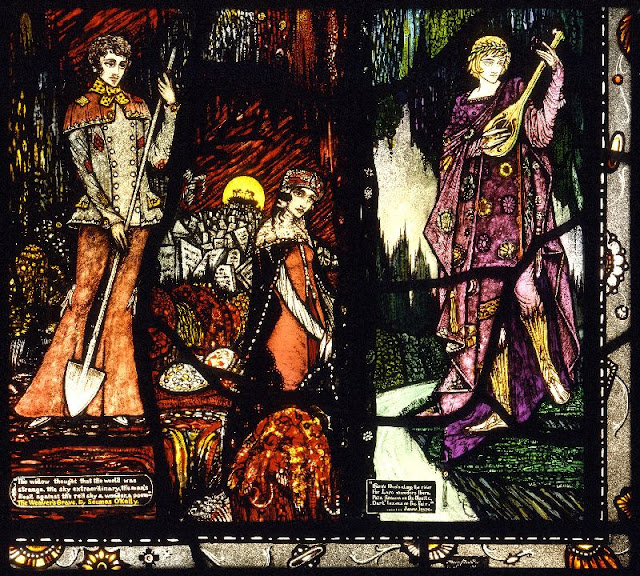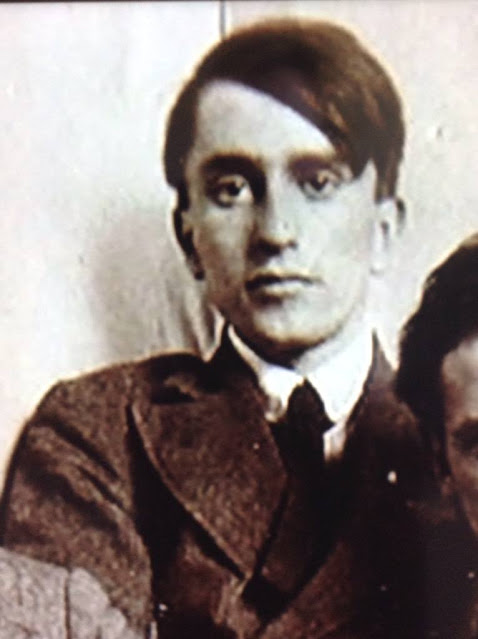Art Scandal: "The Geneva Window" - Esther
“Art scandals” can take many forms. They’re rarely interesting, in spite of what one might think. This particular scandal is perhaps not the form of scandal you’re interested in but to me, it is one of the most strange, lesser known but nevertheless infuriating stories in art.
I take it very personally, I admit. I take to heart all insults to Harry Clarke (Ireland, 1889-1931) & I make no apology for this. I have derived more pleasure, wonder & inspiration from Harry Clarke than almost the whole rest of the art world put together.
You get the idea: he’s my favourite & I’m appalled.
I will deal with the scandal first but I promise to also deal with the art.
The Geneva Window was commissioned in 1926 for the International Labour Building in Geneva as a gift from the Irish Free State. Despite being completed in 1930, it was never used as the Free State’s not-so-free attitudes towards some of the “disgraced” writers whose work was featured in the window meant that the overall air of the window – rather than its artistic merits – was unacceptable to them. Harry even replaced one of the more lewd panels (the original now in the Hugh Lane Gallery in Dublin) but it wasn’t enough.
Over time, I’ve come to understand the government’s position…to some extent. When starting over, you take the opportunity to be represented in ways you find most acceptable to your thinking & philosophy & hopefully shed some stereotypes. In achieving independence, the Republic of Ireland had literally fought for its freedom. People had died in its name & respect was due. There was a great deal of prejudice against the Irish (which sadly has never entirely disappeared in some quarters) & the government was keen for its fledgling self-governing nation to be seen differently & taken seriously. In terms of culture, literature & art, perhaps too seriously.
Today of course, Ireland is a very different place. It is a more secular hive of cultural activity - this has in turn encouraged tourism, helped affect law changes & celebrated many things the Free State was uncomfortable with. It’s complicated.
Preliminary watercolours
The censoring of its writers & artists is one thing. What I can’t forgive however is the disregard & disrespect shown to one of their greatest artists - now & then - & his masterpiece. Here lies the true scandal. Time & again Harry’s appeals for a decision on whether or not his window would be used were ignored or unanswered & it was unusual for him to alter window panels. After all, before undertaking the making of the windows (a task he initially estimated would take at least four months), he had been required to submit preliminary drawings for approval. But by the time the politicians made a decision on how to “dispose” of it, Harry had already died. His studio was paid a mere £450.
The Geneva Window in full
After his death, his wife Margaret was said to be quietly furious about the treatment of the window. The upset with this piece had given him a great deal of anguish in his later months & Margaret bought back the window.
On a personal level, I was irritated to discover I missed seeing the Geneva Window by four years on my first trip to Ireland. It was sold to Mitchell Wolfson in 1988 by Harry’s sons & is now owned by the Wolfsonian in Florida in the Art Deco district at Miami Beach.
Harry Clarke was born in Dublin on St Patrick’s Day in 1889. Initially working for his father’s church decorating business, he showed innate talent as a draughtsman & later took over the business alongside his brother Walter.
As well as specialising in designing & making over 130 windows himself, he was also a supremely gifted illustrator. Harry Clarke was a multi-disciplinary genius.
Despite being commissioned to make windows all over the world and despite much of the work being for churches & convents, some of Harry’s techniques were far from traditional. Even before you reach the details of faces, hands & patterning that are uniquely depicted in his style, you can pick out his work a mile off, whether the piece is religious or secular in nature.
The lines of lead holding the glass panels in place would frequently become key elements of the images in the windows. Harry often used “flashed” glass, i.e. pieces of glass that had been pre-coloured & he would then apply acid to remove the colour, sometimes in incredibly delicate & minute lines.
For instance, having studied it many times, from memory I’d estimate (which I’m not great at) that the head of this “hidden” self portrait in his Eve of St Agnes (1924) window is less than 5cm in height. If you look to the patterning on the right, you can hopefully then gain some sense of how thin these lines really are.
"Hidden" self portrait (1924)
After a lot of rummaging about trying & failing to find the dimensions of the eight individual panels & since the whole Geneva Window is 18.16 x 101.6cm (thank you Wolfsonian!) I estimate this pint of Guinness to be about 3cm in height. The detail is astonishing.
In other sections he would repeatedly paint over & fire pieces of glass to achieve increasingly dimmer or gloomier effects. Using the lead, paint & acid to their full advantage, he could achieve some extremely dark & some extremely pale areas, where the outside light could flood in. Depending on how he wanted to express a certain dynamic, he created tiny pinpricks of light in some of his glass panels that dramatically focus the attention on that place alone.
As I’ve inferred, the Geneva Window was the last major window Harry Clarke worked on. It illustrated extracts from the writing of fifteen 20th Century authors & if commissioned today, it would doubtless be a universal success. Thankfully, Dublin loves all its writers today.
I’ve called this story a scandal, but perhaps it’s more of a tragedy. In any case, despite being treated very badly before Harry’s death, this masterpiece was no better treated afterwards. It was allowed to crack. Twice.
Then his sons were forced to rescue it from the storage vaults of the Dublin Municipal Gallery of Modern Art. The Geneva Window seems finally to be where it will be appreciated. If it wasn’t for lockdown, I may well have been buying my tickets right now.













Comments
Post a Comment